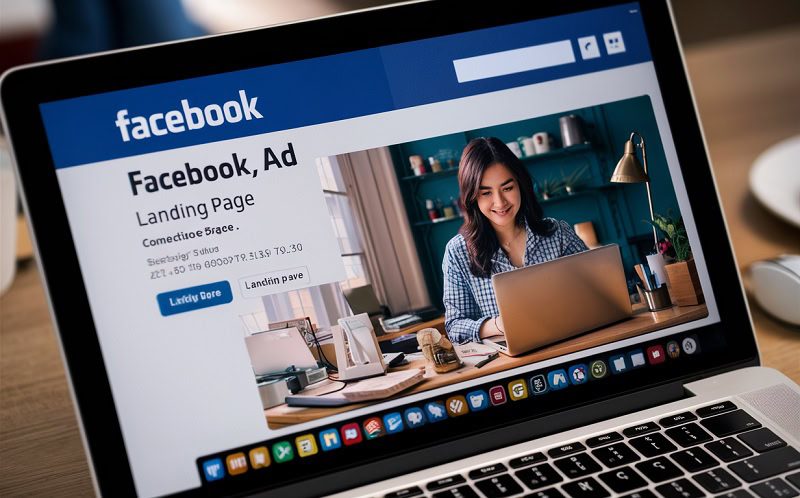Social media marketing is incredibly popular among e-commerce brands, and with good reason.
Paid social provides advertisers with access to enormous audiences, advanced targeting tactics and diverse ad formats. These campaigns have the potential to deliver highly efficient returns for businesses of all sizes.
But before you embark on your social media marketing mission, it’s important to understand how much a campaign is likely to cost.
Managing your marketing budget effectively is crucial to generating maximum conversions and enhancing your social media presence.

Boost E-Commerce ROI: Download Our Free CPA & ROAS Calculator
Since different social media platforms operate with different pricing models, you need to wrap your head around the potential costs involved.
That’s where we can help.
We’ve pulled together all the information you need on running efficient paid social campaigns, the costs of different platforms, and managing your social media budget effectively. Let’s get started.
What is social media marketing?
Social media marketing is a very broad term that can refer to a lot of campaign types.
However, at its core, social media marketing involves using social media platforms to reach your target audiences. This is usually achieved through targeted paid advertising, or the distribution of organic content to existing followers.
There are plenty of social media channels that e-commerce brands can use for advertising.
Some social platforms are geared towards specific audiences – TikTok tends to reach younger demographics, while LinkedIn focuses on business professionals.
Other platforms, such as Facebook and YouTube, offer a much wider reach. Paid advertisers can reach almost any type of consumer with the right targeting tactics.
However, most paid social channels operate in a fairly similar way.
The majority of paid social media platforms require advertisers to:
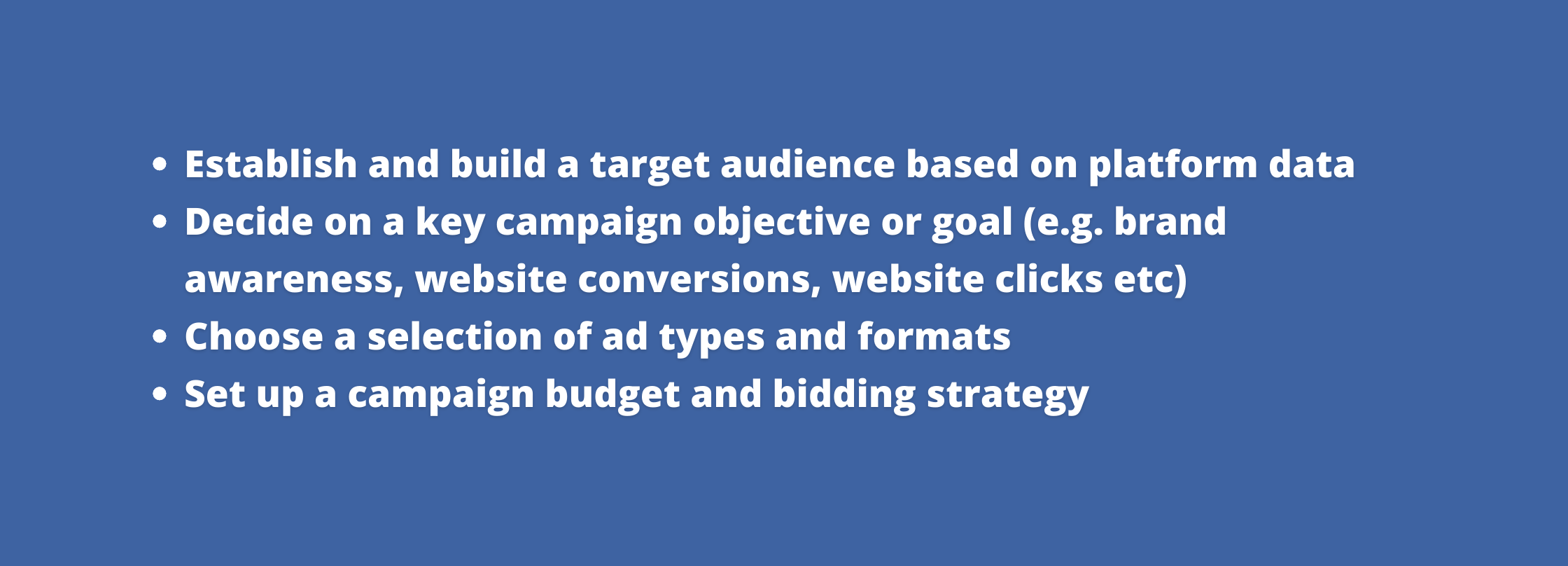
But although there are some obvious similarities between different social channels, there are also important nuances to understand when it comes to pricing models.
Should I run social ads myself, or use a marketing agency?
If you’re considering launching a paid social campaign, you’ll quickly reach a major crossroads.
Should you take ownership of your campaign and run it yourself?
Or should outsource social media marketing to a professional social media management agency?
This can feel like a fairly daunting decision to make, particularly if you’re completely new to the world of social media marketing.
In reality, the pros and cons of each option are fairly clear.
Running paid social ads yourself is cheaper in the short term because you’re not paying for the services of a social media marketing agency.
However, the biggest investment here is time.
Running your own ads is time-consuming.
Firstly, you’ll need to take the time to learn how to launch a campaign, and acquiring these skills can take a while – mastering them can take even longer!
Once you’ve learnt how to set up your ads, you’ll then need to manage campaign measurement, optimisation, and even things like content creation.
Time isn’t a luxury that many e-commerce business owners can afford – particularly if you’re not already experienced with social advertising platforms.
It’s also important to note that although you’re saving up-front costs by running ads yourself, you may also be losing out on revenue and wasting budget in the long term if you’re running inefficient advertising.
Hiring a dedicated marketing agency will incur more costs in the short term because you’re paying for professional social media marketing services.
However, there are a couple of important caveats here.
Firstly, many agencies cater specifically to smaller businesses that are just starting their social media marketing journey. As a result, they understand that they need to charge affordable rates to attract new business.
Secondly, you can think of agency fees as a smart investment rather than an expense.
A marketing expert will be able to expertly handle every aspect of your social media advertising, from campaign set-up to optimisation.
Not only will this save you time (which is a precious commodity for business owners) but it will also help you to deliver optimal returns from your investment, which is important in the long run.
Common factors that influence paid social costs
Several factors can influence the overall cost of social media advertising.
Once you understand the impact of these different factors, you can prepare for cost fluctuations and manage your budget more effectively.
Ad types
The type of ads you run on social platforms will have a major impact on your campaign costs.
Most platforms will provide advertisers with a range of ad formats that aim to achieve different objectives.
For example, an Instagram Shopping ad is designed to drive clicks and conversions, while a YouTube non-skippable video ad will drive video views.
The cost of these ad types will vary, so it’s important to understand how much you’re expecting to bid and the goals you’re looking to achieve.
Some ad types are also exceptionally expensive, such as Twitter Trend Takeovers and YouTube Mastheads. These generally aren’t feasible for small businesses and are often used exclusively by global corporations.
Auction bids
The majority of paid social platforms allocate advertising space based on an auction system.
Advertisers will set up a bidding strategy when launching a campaign that dictates how much they’re willing to pay for an ad impression.
Brands targeting the same audiences and placements will then compete in mini-auctions to deliver their assets and serve impressions. If you win the auction, your ad appears.
The monetary value of your bid is obviously important and will contribute to the cost of your campaigns. However, success in the auction isn’t just determined by the size of your bid.
Social media platforms also place a big emphasis on the quality of your ads and reward advertisers who are running relevant messages. If you’re running highly engaging and relevant ads you can still succeed in the auctions even if you’re bidding less than competitors.
Different platforms judge ‘ad quality’ in different ways – Facebook uses Ad Relevance Diagnostics, while Google uses Quality Score.
Just remember – the value of your bid is important, but you also need to focus on running quality advertising. The better your ads, the more efficient your campaigns will become!
Bidding strategy
Your bidding strategy will also influence the total cost of your paid social campaigns.
It’s important to select a bidding strategy that aligns closely with your campaign and business objectives.
For example, when you’re setting up a new campaign, you’ll usually be prompted to confirm the actions you’re bidding for (e.g. clicks, video views), the amount you’re willing to pay, and the bidding strategy you’d like to utilise.
You might prefer to set a definitive cap on your bids to control spending, or you might instruct the platform to deliver as many conversions as possible with a more flexible budget.
It all depends on your core goals and digital marketing budget.
If you’re bidding to achieve actions that aren’t contributing to your primary objectives, you’re essentially just wasting your budget.
Competitor activity
Since you’ll be bidding against other brands to deliver ad impressions through the auction, competitor activity is another major factor in dictating your costs.
If your competitors are actively targeting similar audiences and bidding higher amounts, you’ll need to increase your bids to stay competitive.
This is why certain times of the year (e.g. Black Friday, Christmas, and January sales) can be particularly expensive for paid social advertising.
When a huge number of advertisers are flooding social platforms with high-frequency ads and eye-watering budgets, auctions can rapidly become very pricey.
You need to plan carefully if you’re going to advertise during these hectic periods. Although there’s a big revenue opportunity, you also risk burning through your budget to achieve sufficient reach.
What are the costs associated with different networks?
The price you pay for social media marketing will often fluctuate based on the platform you’re using.
It’s difficult to confidently estimate how much ads will cost on each platform because so many factors can influence the price.
For example, businesses will pay very different amounts for ads based on their industry.
Some industries (such as finance and insurance) generally pay much higher social media advertising costs, while others (such as online retail) can run cheaper campaigns.
However, there are some average costs that we can look at for social media platforms to provide you with some rough guidelines.
(It’s worth noting that different partners operate with different metrics and pricing models, so some costs will be unique to a specific platform.)
Below is a breakdown of average costs for Facebook ads:

Below is a breakdown of average costs for Twitter advertising:

Below is a breakdown of average costs for Instagram advertising:

Below is a breakdown of average costs for LinkedIn advertising:
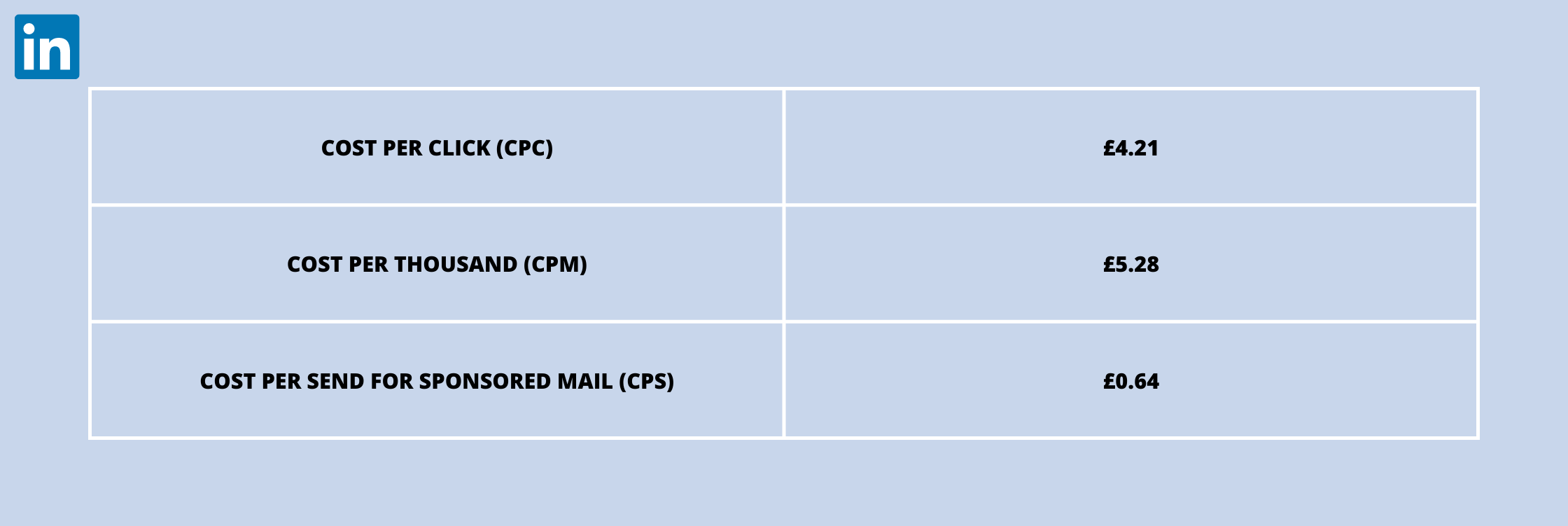
Below is a breakdown of average costs for Pinterest advertising:
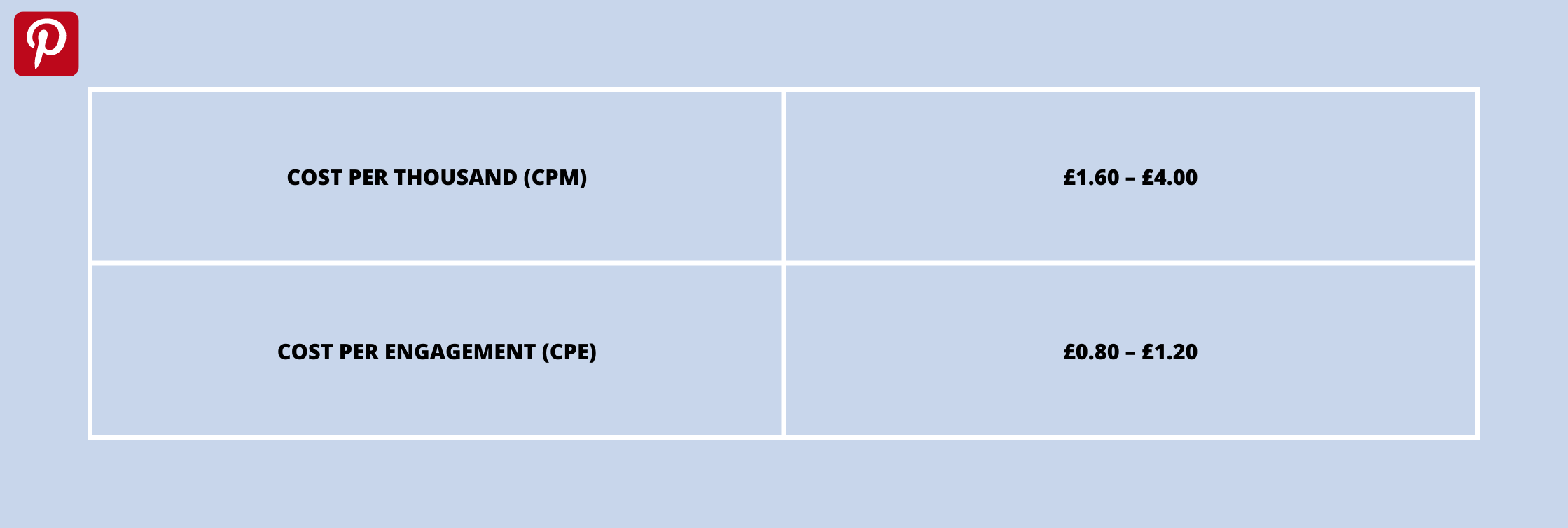
Snapchat
Below is a breakdown of average costs for Snapchat advertising:

TikTok
Below is a breakdown of average costs for TikTok advertising:
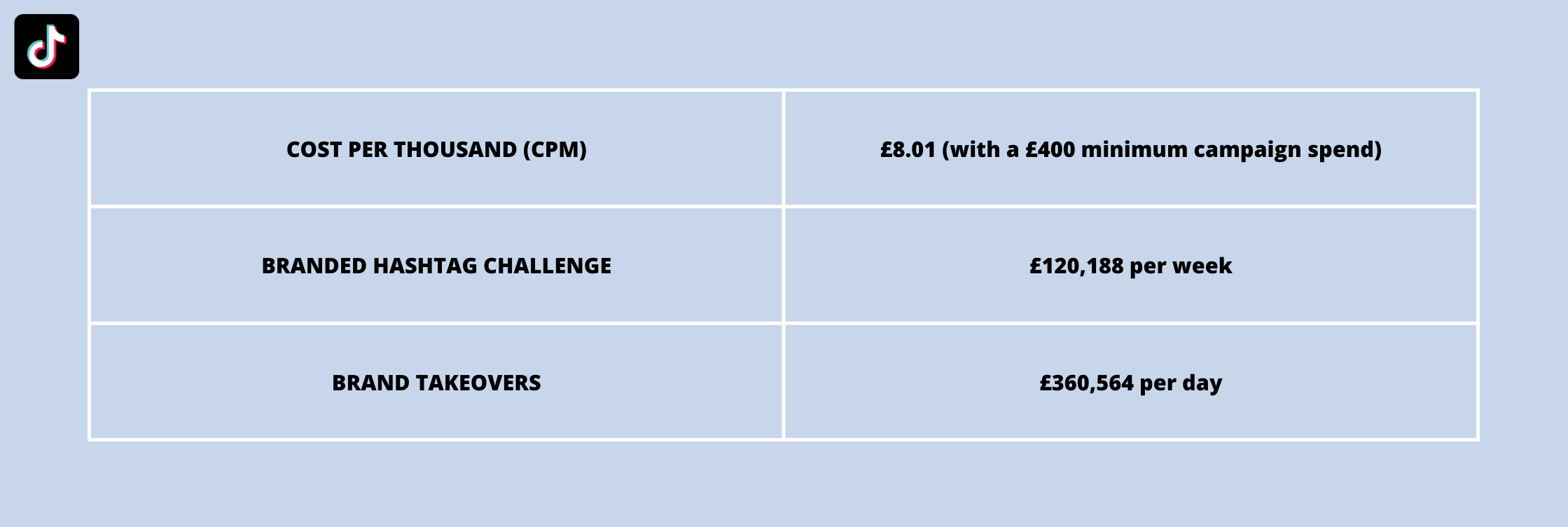
YouTube
Below is a breakdown of average costs for YouTube advertising:
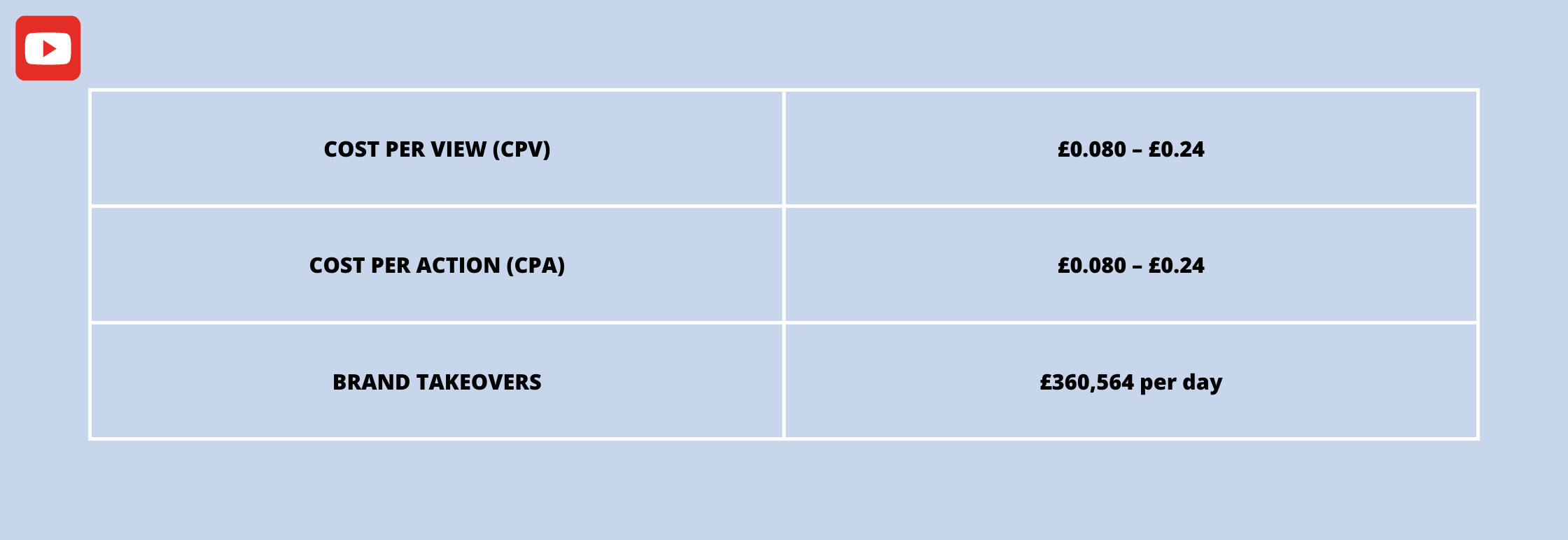
As you can see, costs vary significantly between different paid social partners and different campaign objectives.
It’s important to remember that these are also average costs for each platform. Your own costs will be dictated by several factors, so keep a close eye on your spend.
How to reduce social media marketing costs
Now that you’re familiar with the average cost for different paid social networks, let’s tackle the big question.
How can you bring these costs down and run ultra-efficient social media ads?
Fortunately, there’s a lot that advertisers can do to minimise wasted spend and make their budgets work as hard as possible.
Let’s run through some of the main tactics that can help to reduce costs:
1. Run high-quality and relevant campaigns
Succeeding in paid social auctions is key to increasing the reach and effectiveness of your campaigns.
However, coming out on top in these auctions isn’t all about the size of your bid.
By running creative, engaging, and relevant campaigns, you can improve your auction performance while also paying less for your impressions.
Sounds like a winner, right?
It’s very important to consider your target audience when producing creative assets and setting up campaigns.
Is your messaging going to be helpful, relevant and genuinely interesting for these users?
Are your ads and CTAs tailored to this specific audience?
Could your campaigns be suffering from creative fatigue?
It’s also a good idea to double-check what each platform considers to be a ‘good quality’ advertisement because the criteria will differ.
Facebook, for example, rewards advertisers based on the perceived quality of their ads, their expected engagement rate, and their expected conversion rate.
Twitter, on the other hand, judges ads based on slightly different metrics – Resonance, Relevance and Recency.
Think about the criteria of each platform when you’re pulling campaigns together, and make sure that you’re delivering high-quality assets.
2. Regularly optimise your ads
Effectively optimising your paid social campaigns is crucial to reducing your expenditure.
When you launch a new campaign, you’ll probably be testing various approaches, such as different audiences, different ad formats and different creative assets.
Not all of these approaches will be successful, and some may prove to be inefficient or expensive. This is where optimisations are key.
When you optimise your campaigns, you can pause or remove any formats, audiences or assets that aren’t delivering positive returns. This budget can then be redirected towards tactics that are proving to be more successful.
This process prevents wasted budget and improves the efficiency of your investment.
If you launch a new campaign and then fail to make any optimisations, you could essentially be throwing money away. Some tactics may be struggling to deliver results, while others may be costing an excessive amount.
Make sure that you’re regularly monitoring campaign reports to identify both high-performing and ineffective tactics.
3. Focus on insightful A/B testing
A thorough A/B testing strategy is one of the best ways to reduce your advertising costs and improve campaign performance.
By regularly conducting different tests, you can discover brand new tactics that deliver strong results for your business and increase revenue.
For example, let’s say that you’re running a product image ad that’s performing relatively well and delivering a 0.75% Click Through Rate.
Rather than leaving this asset to run its course, you decide to set up an A/B test. Smart.
You run the same product image ad and target an identical audience, but write a fresh headline and include a new CTA. This new test asset runs with the same budget as the original ad but delivers a 0.90% CTR.
By repeating and refining this process over time, you can identify your strongest assets and consistently improve performance, meaning increased clicks and conversions.
Most social media platforms will also allow you to run automated tests, where you simply need to set up your testing strategy and confirm your ad budgets.
The algorithms will then run A/B tests for you and optimise campaigns automatically based on the results. Who doesn’t love a bit of machine learning?
Optimising social media marketing for ROI
Regardless of the platform you’re using for paid social advertising, you’ll ultimately be focusing on the same objective.
You’ll want to achieve a positive and consistent Return On Investment (ROI).
A good ROI will differ for every business because it all depends on your specific goals and business objectives. You might be focusing on driving online sales, email subscriptions, e-book downloads or social engagements.
However, you’ll always need your paid social budget to deliver results that make the time, money, and resources you’ve invested worthwhile.
Below are some proven marketing strategies that can help to optimise your social media ROI.
Set up tracking pixels where possible
Pixels are incredibly useful pieces of code that can be placed on your e-commerce website.
This code can track conversions from social media ads, help you to optimise campaigns effectively, and provide you with valuable data for audience building.
Using a pixel allows you to bridge the gap between social media platforms and your online store, so you can see which clicks have resulted in actual sales.
This means that you can identify and retarget valuable prospects to develop a more profitable social media marketing strategy.
Without a pixel in place, you won’t be able to optimise product sales and revenue, which means that your campaigns will inevitably be less efficient.
The process for installing a pixel differs between social media platforms, but each website will provide you with specific instructions on how to set up the code.
Unfortunately, we can’t discuss pixels and retargeting without an ominous reference to iOS updates. These privacy updates have made pixel usage a little more complex when it comes to Apple users, but fear not – our guide on the subject explains all.
Use the ROAS calculation to guide optimisations
If you’re going to run wildly efficient social media ads, then you’ll also need to stay focused on the most important metrics.
It’s all too easy to become overwhelmed with campaign data, particularly if you’re unsure of the right numbers to track.
Reach, impressions, clicks, shares – which metrics actually matter!?
To stay on track and successfully optimise your ads, it’s a good idea to utilise the Return On Ad Spend (ROAS) calculation throughout your campaign.
So what is the ROAS calculation?
Just divide your advertising revenue (i.e. your total income from advertising) by your social media marketing cost (i.e. the amount you’ve spent on a campaign.)
This is a simple calculation, but one that highlights how efficiently your ads are working based on your expenditure.
A healthy ROAS will differ based on your industry, but at a bare minimum, you never want your ROAS to drop below 1.
That would mean that you’re generating less than £1 for every £1 spent, which is a major red flag for efficiency.
(This is particularly true when you include the costs of goods sold, platform fees, and anything else you’d want to include in your breakeven ROAS target.)
If you’re ever unsure of how efficient your social media ads are, double-check your ROAS, and focus on the tactics that are delivering the best returns.
Managing your social media marketing budget
It’s important to understand the costs associated with different social platforms, but it’s also crucial to understand how to manage your budget properly.
Fortunately, a few good habits can keep you on the path to social media success.
Keep a close eye on your reports
If you’re going to control your internet marketing budget effectively, you need to check how much you’re spending throughout your campaign.
That means regularly accessing reports to monitor total spend delivery, budget pacing, and performance.
Sounds simple, but this is incredibly important for social media management.
Make informed optimisations
Implementing frequent and impactful optimisations will help to improve the returns delivered by your investment.
Be sure to check the performance of your ad formats, creative assets and audiences to adjust your budgets and prioritise high-performing strategies.
Don’t be afraid to use automation
Many social media partners allow advertisers to automate certain aspects of budget management, such as daily spend, bidding, and optimisations.
This can be extremely helpful, so don’t hesitate to lean on algorithms and machine learning.
Platforms collect mountains of valuable campaign data over time, and they can use these insights to make profitable decisions on your behalf.
Getting started with social media campaigns
You’re now equipped with all the knowledge you need to launch an effective social media strategy and manage your social campaign budgets.
Each paid social platform will require you to follow specific steps to get started, but below is a handy checklist that you can reference before launching an ad campaign:
1. Make sure that your social media platform account is set up with the relevant business details
2. Start your campaign set-up with a clear marketing budget in mind
3. Explore the audiences and targeting options available on each platform
4. Ensure that any campaign tracking (e.g. pixels) is set up before launch
5. Check out ad specifications before producing creative assets
The costs of social media marketing will always fluctuate across platforms, and a wide array of factors can impact the total price of a campaign.
However, that doesn’t mean you can’t take control of your paid social budget.
By paying close attention to your campaign reports, making speedy optimisations and improving the quality of your ads, you can make sure that your budget achieves optimal returns.





